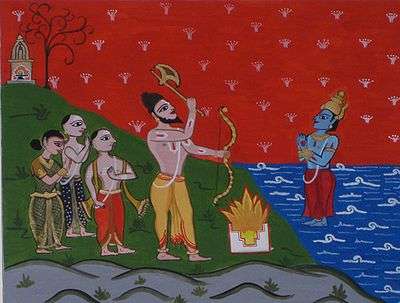Goud Saraswat Brahmin
| Regions with significant populations | |
|---|---|
| Primary populations in Karnataka, Goa and Maharashtra[1] | |
| Religion | |
| Hinduism | |
| Related ethnic groups | |
| Saraswat Brahmins |
Goud (also spelt as Gaud or Gawd) Saraswat Brahmins are a Hindu Brahmin community in India and a part of the larger Saraswat Brahmin community. They belong to the Pancha (five) Gauda Brahmana groups. They are popularly referred to by the acronym GSB. They primarily speak Konkani as their mother tongue.

History
Reference to Saraswat names are found in Shilaharas as well as Kadamba copper plate inscriptions.The inscriptions found in Goa bear testimony to the arrival of Brahmin families in the Konkan region.[2] Sahyadrikhanda and Mangesh Mahatmya allude to migrations of Saraswat brahmins, constituting sixty-six families, who settled in eight villages of Goa. There were regional variations among the Saraswats, such as those among Bardeskars, Pednekars and Sastikars. The Konkana mahatmya, from the 17th century CE, deals with the internal rivalry of the Saraswats and strained relations between these groups.[3] In Kalhana's Rajatarangini (12th century CE), the Saraswats are mentioned as one of the five Pancha Gauda Brahmin communities residing to the north of the Vindhyas.[4]
The GSB ancestors identified themselves as of the Saraswat section of the northern Gaud division, in contrast to their Maharashtra and Karnataka Brahman neighbors of the southern division. Many Saraswats left Goa after the invasion of Malik Kafur to the neighbouring regions and during the period of religious persecution of the Portuguese also Saraswats migrated to Uttar Kannada), Dakshina Kannada and North Konkan. The Saraswat Brahmins particularly served as Administrators,village revenue collectors (Kulkarnis, financiers,landlords,Priests,Teachers and Merchants in the intra-Asian trade, and diplomats. Many sources of government income in Goa, Konkan and elsewhere, including taxes on commodities and customs duties, remained in their hands.[2]
Origin myth
The River Saraswati
The Saraswat Brahmins believe themselves to be named after the mythical Saraswati river, which was thought to arise in the Himalayas and flow through the present Punjab and Rajasthan region to the western sea near Dwaraka, in Gujarat. Saraswat brahmins are mentioned in the Ramayana, Mahabharata and Bhavishya Purana.[5]The Saraswati river of Rigvedic and Vedic texts has been historically identified with parts of watercourses near Lake Pushkar in Rajasthan, Sidhpur in Northern Gujarat and Somnath in Saurashtra, Gujarat. A popular belief identifies it with an underground flow at Prayag, Allahabad, emerging at the confluence of Ganga and Yamuna to form the Triveni Sangam. It has been suggested that around 1000 BCE the Yamuna breached and permanently drained the Sarwasati, the most important water course of the Swati Valley civilisation and early Vedic Civilisation; the desertification of their homeland would have compelled the Saraswati migration to the other parts of Bharat Khanda.According to the Sahyadrikhanda of the Skanda Purana, ninety-six Brahmin families belonging to ten gotras migrated to Goa from western India, along with Parashurama.[6][7] Linguistic evidence for such a migration of Saraswats to Konkan and Deccan is based on distribution of Indo-Aryan linguistic expansions, beginning before 500 BCE.[8]
Tradition and culture
Cuisine
People
See also
References
- ↑ Lola Nayar (1 October 2012). "The Konkan Rail". Outlook India. Retrieved 8 October 2016.
- 1 2 Pinto, Celsa (1994). Trade and Finance in Portuguese India: A Study of the Portuguese Country Trade, 1770–1840 (Volume 5 of Xavier Centre of Historical Research Porvorim: XCHR studies series ed.). Concept Publishing Company. pp. 53–56. ISBN 9788170225072.
- ↑ Konkana Mahatmya. Samant hari. pp. 21–34.
- ↑ D. Shyam Babu and Ravindra S. Khare, ed. (2011). Caste in Life: Experiencing Inequalities. Pearson Education India. p. 168. ISBN 9788131754399.
- ↑ D. Shyam Babu and Ravindra S. Khare, ed. (2011). Caste in Life: Experiencing Inequalities. Pearson Education India. p. 168. ISBN 9788131754399.
- ↑ Shree Scanda Puran (Sayadri Khandha) -Ed. Dr. Jarson D. Kunha, Marathi version Ed. By Gajanan shastri Gaytonde, published by Shree Katyani Publication, Mumbai
- ↑ Gomantak Prakruti ani Sanskruti Part-1, p. 206, B. D. Satoskar, Shubhada Publication
- ↑ Mitragotri, Vithal Raghavendra (1999). A socio-cultural history of Goa from the Bhojas to the Vijayanagara. Institute Menezes Braganza. pp. 50–54.
Further reading
- Suryanath U Kamath (1992). The origin and spread of Gauda Saraswats.
- Venkataraya Narayan Kudva (1972). History of the Dakshinatya Saraswats. Samyukta Gauda Saraswata Sabha.
- Ramachandra Shyama Nayak. "Saraswath Sudha".
- Kawl, M. K. Kashmiri Pandits: Looking to the Future.
- Bryant, Edwin (2001). The Quest for the Origins of Vedic Culture. Oxford University Press. ISBN 0-19-513777-9.
- Hock, Hans (1999) "Through a Glass Darkly: Modern "Racial" Interpretations vs. Textual and General Prehistoric Evidence on Arya and Dasa/Dasyu in Vedic Indo-Aryan Society." in Aryan and Non-Aryan in South Asia, ed. Bronkhorst & Deshpande, Ann Arbor.
- Shaffer, Jim G. (1995). "Cultural tradition and Palaeoethnicity in South Asian Archaeology". In George Erdosy. Indo-Aryans of Ancient South Asia. ISBN 3-11-014447-6.
- Conlon, Frank F. (1974). "Caste by Association: The Gauda Sarasvata Brahmana Unification Movement". The Journal of Asian Studies. 33 (3): 351–365. JSTOR 2052936. doi:10.2307/2052936. (Subscription required (help)).